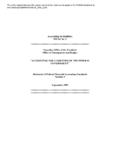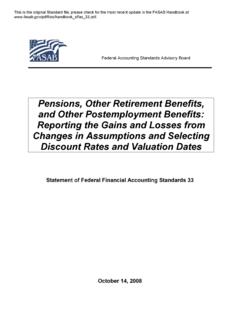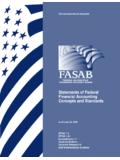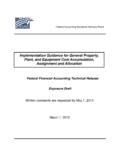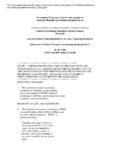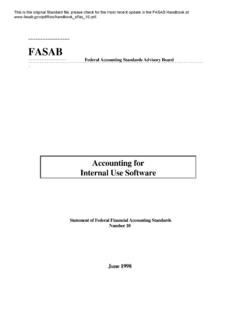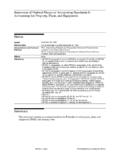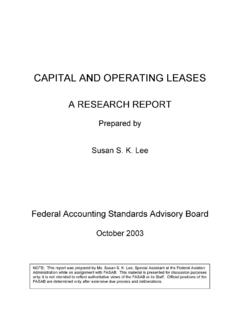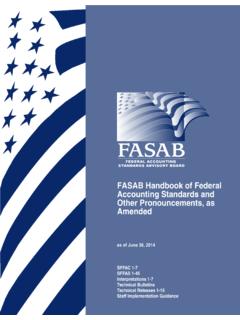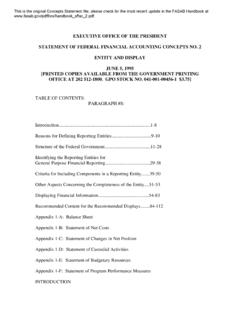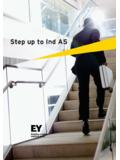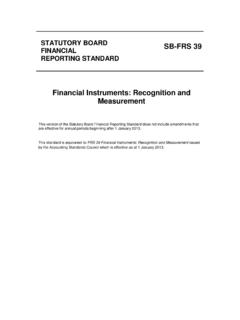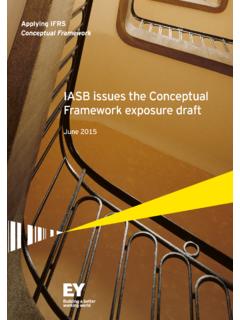Transcription of RECOGNITION OF CONTINGENT LIABILITIES ARISING FROM …
1 FASABF ederal Accounting Standards Advisory BoardRECOGNITION OF CONTINGENT LIABILITIES ARISINGFROM LITIGATION: An Amendment ofSFFAS No. 5, Accounting for LIABILITIES of the Federal GovernmentStatement of Federal Financial Accounting StandardsNumber 12 December 1998 This is the original Standard file; please check for the most recent update in the FASAB Handbook at Accounting Standards Advisory BoardAccounting for LIABILITIES of the Federal GovernmentDecember 1998 THE FEDERAL ACCOUNTING STANDARDS ADVISORY BOARD The Federal Accounting Standards Advisory Board (FASAB, or the Board ) was established inOctober 1990 by the Secretary of the Treasury, the Director of the Office of Management and Budget(OMB), and the Comptroller General.
2 The nine-member Board was created to consider andrecommend accounting principles for the federal government. The Board communicates its recommendations by publishing recommended accountingconcepts and standards after considering the financial and budgetary information needs ofcongressional oversight groups, executive agencies, and other users of federal financialinformation. The Board also considers comments from the public on its proposedrecommendations, which are published for comment as "exposure drafts." After consideringoral and written comments, the standards may be recommended by the Board. The Board ssponsors then decide whether to adopt the recommendations.
3 If adopted, the standard ispublished by the OMB and the General Accounting Office and become following documents related to the establishment and mission of the Board are availablefrom the FASAB:(1) the "Memorandum of Understanding among the General Accounting Office, theDepartment of the Treasury, and the Office of Management and Budget on FederalGovernment Accounting Standards and a Federal Accounting Standards AdvisoryBoard"(2) the "Mission Statement of the Federal Accounting Standards Advisory Board"This is the original Standard file; please check for the most recent update in the FASAB Handbook at SUMMARYF ederal Accounting Standards Advisory BoardAccounting for LIABILITIES of the Federal GovernmentDecember 1998 This recommended accounting standard amends Statement of Federal Financial AccountingStandards Number 5, Accounting for LIABILITIES of the Federal Government (SFFAS No.)
4 5). Itprovides an exception to the CONTINGENT liability standard for recognizing loss contingencies onmatters of pending or threatened litigation and unasserted claims. For loss contingencies covered by the exception, a CONTINGENT liability would be recognized1 whena future outflow or other sacrifice of resources is likely to occur, a past event or exchangetransaction has occurred, and the future outflow or sacrifice of resources is measurable. Beforethe amendment, SFFAS No. 5 called for RECOGNITION when an outflow is "more likely than not." In addition to RECOGNITION , disclosure2 would be required for loss contingencies on matters ofpending or threatened litigation and unasserted claims if it is at least reasonably possible that aloss or an additional loss may have been incurred.
5 The amendment does not affect RECOGNITION ofother types of contingencies. 1 The term recognize means the formal recording or incorporating of an item into the financial statements of an entity as an asset, liability,revenue, expense, etc. See FASAB Consolidated The term disclosure means the reporting of information in notes or narrative regarded as an integral part of the basic financial statement. SeeFASAB Consolidated is the original Standard file; please check for the most recent update in the FASAB Handbook at OF CONTENTSF ederal Accounting Standards Advisory BoardAccounting for LIABILITIES of the Federal GovernmentDecember 2 EFFECTIVE 2 ACCOUNTING 3 APPENDIX A: BASIS FOR 4 APPENDIX B: Selected Section from Statement of Financial Accounting Standards , Accounting for 6 APPENDIX C: Selected Sections of Statement of Federal Financial Accounting StandardsNo.
6 5, Accounting for LIABILITIES of the Federal 7 This is the original Standard file; please check for the most recent update in the FASAB Handbook at Accounting Standards Advisory BoardAccounting for LIABILITIES of the Federal GovernmentDecember Statement amends Statement of Federal Financial Accounting StandardsNumber 5 (SFFAS No. 5), Accounting for LIABILITIES of the Federal Government,to provide an exception to the CONTINGENT liability standard for matters of pendingor threatened litigation and unasserted claims. The proposed amendment wouldaffect accounting for contingencies under SFFAS No. 5 by inserting an exceptionto the definition of probable and to the RECOGNITION criteria in SFFAS No.
7 5 (seecurrent paragraphs 33, 36, and 38 of that standard in Appendix C). standard applies to evaluations and accounting RECOGNITION and disclosure ofthe future outcome of Federal Accounting Standards Advisory Board (FASAB) was asked to clarifythe application of the standard for recognizing loss contingencies for pending orthreatened litigation and unasserted claims. SFFAS No. 5 provides the definitionfor "liability" and establishes specific standards for five liability categories,including No. 5 defines a contingency as an existing condition, situation, or set ofcircumstances involving uncertainty as to possible gain or SFFAS No. 5requires a liability to be recognized for loss contingencies when a past event orexchange transaction makes a future outflow of resources probable It defines "probable" as that which can reasonably be expected orbelieved to be more likely than not on the basis of available evidence or logic butwhich is neither certain nor No.
8 5 uses the same general framework for evaluating loss contingenciesas Financial Accounting Standards Board (FASB) Statement of Financial 3 SFFAS No. 5, par. 35, and also in Appendix SFFAS , par. SFFAS No. 5, par. 33 and also see SFFAS No. 5 s is the original Standard file; please check for the most recent update in the FASAB Handbook at Accounting Standards Advisory BoardAccounting for LIABILITIES of the Federal GovernmentDecember 1998 Accounting Standards No. 5, Accounting for Contingencies (SFAS No. 5).Contingencies can be "probable," "reasonably possible," or "remote;" and, basedon that, are recognized on the balance sheet, disclosed in footnotes, or notmentioned in the financial statements, respectively.
9 However, SFAS No. 5 defines"probable" as "likely to occur" instead of "more likely than not." auditors have expressed reservations about their ability under Statement ofAuditing Standards 12 (SAS 12) to express an unqualified opinion on the entity'sfinancial statements without a legal representation letter that refers to theSFFAS No. 5 standard. Lawyers have expressed serious objection to thedefinition of probable ( more likely than not ) contained in SFFAS No. 5. Theystate that a lawyer s prediction of failure under the SFFAS No. 5 definition of probable ( more likely than not ), and the recording of a liability to reflect thatjudgment, could be used as an admission against interest, thereby jeopardizing thegovernment s ability to fairly defend the public interest.
10 Similarly, they furtherstate that a lawyer s response to an auditor s request for information on matterswhere an unfavorable outcome is more likely than not could result in thedisclosure of information protected by the lawyer-client privilege, disadvantagingthe government in any dispute, and violating the American Bar Association sCode of Professional Board believes that this amendment clarifies the standard for contingenciesinvolving pending or threatened litigation and unasserted claims and will facilitatecommunication among auditors, lawyers, those who prepare financial statements,and those who use the financial provisions of this statement need not be applied to immaterial standard is effective for reports issued subsequent to the date of thisstatement for reporting periods beginning after September 30, 1997.
